《语言学教程》第6章语言和认知
胡壮麟语言学教程Chapter6

• Father: ‘You’d better take them off and put them on frontwards.’
• Daughter (Taking them off and turning them around):
•
‘Is this the rightwards?
• Daughter: Somebody’s at the door.
• Father / linguist (Supervising daughter getting dressed):
•
‘I think you’ve got your underpants on backwards.’
• Daughter (age 3 years 9 months): ‘Yes, I think so.’
• Child: Daddy, you’re interring up.
•
inter up interrupt
• Later development • Negation: • Stage 1 (approximately 18 to 25 months) • No the sun shining. • No sit there. • No dog bite you. • No mom sharpen it.
• 6.2.1 Language acquisition
• 1) Holophrastic stage
• So runs my dream, but what am I?
•
An infant cryingying for the light,
•
Chapter 6 Language and Cognition
语言学教程chapter6 language and cognition

Examples: Physical: Paths; Trajectories Metaphorical: The purpose-as-physicalgoal metaphor, as expressed in the following sentences:
Tom has gone a long way toward changing his personality. You have reached the midpoint of your flight training. She's just starting out to make her fortune. Jane was sidetracked in her search for selfunderstanding.
Examples
Days Weeks Years Sleeping and waking Breathing Circulation Emotional buildup and release
Force schema 力图示
Involves physical or metaphorical causal interaction. It includes the following elements:
Scale schema范围图示
Involves an increase or decrease of physical or metaphorical amount, and consists of any of the following:
Figure-ground reversal
胡壮麟《语言学教程》(第5版)笔记和考研真题详解
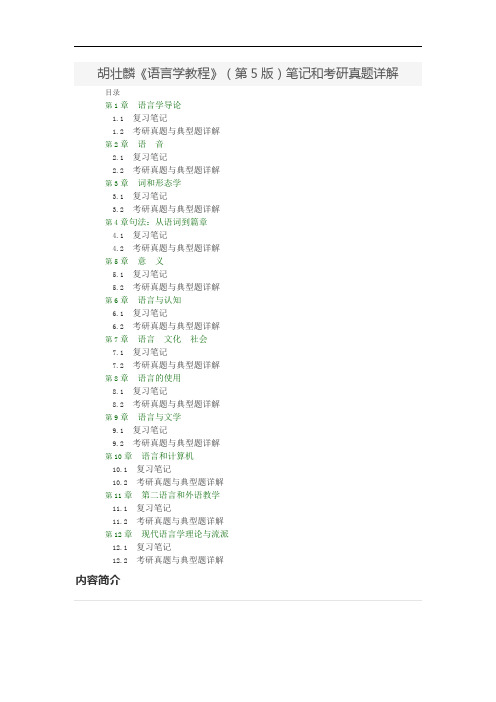
胡壮麟《语言学教程》(第5版)笔记和考研真题详解目录第1章语言学导论1.1复习笔记1.2考研真题与典型题详解第2章语音2.1复习笔记2.2考研真题与典型题详解第3章词和形态学3.1复习笔记3.2考研真题与典型题详解第4章句法:从语词到篇章4.1复习笔记4.2考研真题与典型题详解第5章意义5.1复习笔记5.2考研真题与典型题详解第6章语言与认知6.1复习笔记6.2考研真题与典型题详解第7章语言文化社会7.1复习笔记7.2考研真题与典型题详解第8章语言的使用8.1复习笔记8.2考研真题与典型题详解第9章语言与文学9.1复习笔记9.2考研真题与典型题详解第10章语言和计算机10.1复习笔记10.2考研真题与典型题详解第11章第二语言和外语教学11.1复习笔记11.2考研真题与典型题详解第12章现代语言学理论与流派12.1复习笔记12.2考研真题与典型题详解内容简介作为《语言学教程》(第5版)(胡壮麟主编,北京大学出版社)的学习辅导书,全书完全遵循该教材的章目编排,共分12章,每章由两部分组成:第一部分为复习笔记(中英文对照),总结本章的重点难点;第二部分是考研真题与典型题详解,精选名校经典考研真题及相关习题,并提供了详细的参考答案。
本书具有以下几个方面的特点:1.梳理章节脉络,浓缩内容精华。
每章的复习笔记以该教材为主并结合其他教材对本章的重难点知识进行了整理,并参考了国内名校名师讲授该教材的课堂笔记,因此,本书的内容几乎浓缩了经典教材的知识精华。
2.中英双语对照,凸显难点要点。
本书章节笔记采用了中英文对照的形式,强化对重要难点知识的理解和运用。
3.精选考研真题,补充难点习题。
本书精选名校考研真题及相关习题,并提供答案和详解。
所选真题和习题基本体现了各个章节的考点和难点,但又不完全局限于教材内容,是对教材内容极好的补充。
另外,在笔记部分,对于在《语言学教程》第三版或第四版提到而第五版删减的知识点我们也予以保留,并用“*”标明,部分院校考研真题依旧会涉及这些知识点的考查。
语言学教程Chapter 6. Language and Cognition课件
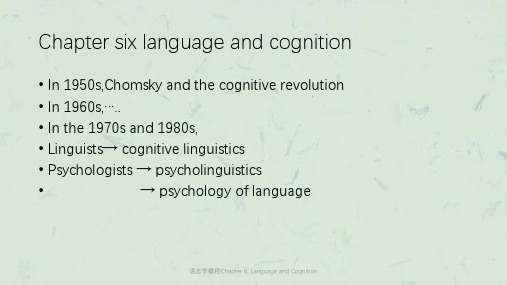
语言学教程Chapter 6. Language and Cognition
(1) Access to words
• Steps involved in the planning of words: • 1. processing step, called conceptualization,…… • 2.to select a word that corresponds to the chosen concept. • 3.morpho-phonological encoding • Generally, morphemes are accessed in sequence, according to
• 1). Serial models…… • 2). Parallel models…… • Structural factors in comprehension of sentences • 1). minimal attachment which defines “structural simpler” • 2).“Garden path” • Lexical factors in comprehension • Information about specific words is stored in the lexicon.
语言学教程Chapter 6. Language and Cognition
6.2.3 language production
• Language production involves…… • 1. generation of single words • 2. generation of simple utterances • Different mappings in language comprehension and in language production • Discussions: • A. production of words orally, • B. production of longer utterances, • C. the different representations and processes involved in spoken production
胡壮麟语言学教程笔记、重点

《语言学教程》重难点学习提示第一章语言的性质语言的定义:语言的基本特征(任意性、二重性、多产性、移位、文化传递和互换性);语言的功能(寒暄、指令、提供信息、询问、表达主观感情、唤起对方的感情和言语行为);语言的起源(神授说,人造说,进化说)等。
第二章语言学语言学定义;研究语言的四大原则(穷尽、一致、简洁、客观);语言学的基本概念(口语与书面语、共时与历时、语言与言学、语言能力与言行运用、语言潜势与语言行为);普通语言学的分支(语音、音位、语法、句法、语义);;语言学的应用(语言学与语言教学、语言与社会、语言与文字、语言与心理学、人类语言学、神经语言学、数理语言学、计算语言学)等。
第三章语音学发音器官的英文名称;英语辅音的发音部位和发音方法;语音学的定义;发音语音学;听觉语音学;声学语音学;元音及辅音的分类;严式与宽式标音等。
第四章音位学音位理论;最小对立体;自由变异;互补分布;语音的相似性;区别性特征;超语段音位学;音节;重音(词重音、句子重音、音高和语调)等。
第五章词法学词法的定义;曲折词与派生词;构词法(合成与派生);词素的定义;词素变体;自由词素;粘着词素(词根,词缀和词干)等。
第六章词汇学词的定义;语法词与词汇词;变词与不变词;封闭词与开放词;词的辨认;习语与搭配。
第七章句法句法的定义;句法关系;结构;成分;直接成分分析法;并列结构与从属结构;句子成分;范畴(性,数,格);一致;短语,从句,句子扩展等。
第八章语义学语义的定义;语义的有关理论;意义种类(传统、功能、语用);里奇的语义分类;词汇意义关系(同义、反义、下义);句子语义关系。
第九章语言变化语言的发展变化(词汇变化、语音书写文字、语法变化、语义变化);第十章语言、思维与文化语言与文化的定义;萨丕尔-沃夫假说;语言与思维的关系;语言与文化的关系;中西文化的异同。
第十一章语用学语用学的定义;语义学与语用学的区别;语境与意义;言语行为理论(言内行为、言外行为和言后行为);合作原则。
英语考研 胡壮麟版 语言学教程 English Linguistics Chapter 6
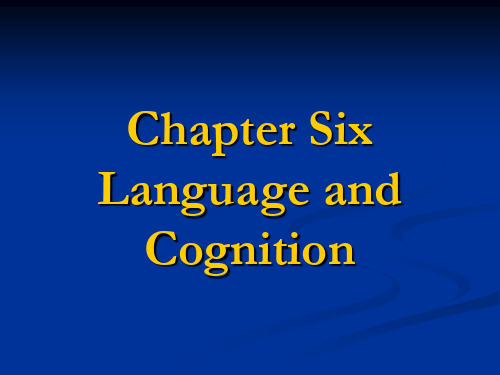
accessed due to its more frequent usage in the language. 4. Recency effect: describe the additional ease with which a word is
12
2.2 Language comprehension
Mental lexicon: information about the properties of words, retrievable when understanding language
For example, we may use morphological rules
15
The cohort theory hypothesizes that auditory word recognition begins with the formation of a group of words at the perception of the initial sound and proceeds sound by sound with the cohort of words decreasing as more sounds are perceived.
In certain cases, listeners’ knowledge of words can lead to the inhibition of certain phonemes.
胡壮麟《语言学教程》第一章-第六章重难点

名词解释Syntactic function/ predicate/ performance/ tone/ semi-vowels/ minimal pairs/ intonation/ competence/ proposition/ cognitionMinimal pair, semi vowels, tone, intonation, competence, performance, predicate, syntactic function, proposition, cognition, conceptual metaphors, image schemas, hyponymy, endocentric construction, inflection Minimal pair refers to a pair of words, as pin and bin, or sheep and ship, differing only by one sound in the same position in each wordSemi-vowels The segments are neither vowels nor consonants but midway between the two categories.Intonation the occurrence of recurring fall-rise patterns, each of which is used with a set of relatively consistent meanings, either on single words or on groups of words of varying length. Tone a set of fall-rise patterns affecting the meanings of individual words.Predicate refers to a major constituent of sentence structure in binary analysis in which all obligatory constituents other than the subject were considered together.A language user’s underlying knowledge about the system ofrules is called his linguistic competence.Performance refers to the actual use of language in concrete situation.Syntactic function shows the relationship between a linguistic form and other parts of the linguistic pattern in which it is used. Cognition In psychology it is used to refer to the mental processes of an individual, with particular relation to a view that argues that the mind has internal mental states and can be understood in terms of information processing, especially when a lot of abstraction or concretization is involved, or processes such as involving knowledge, expertise or learning for example are at work. In cognitive linguistics, cognition refers to the conceptualization of linguistic structures and patterns.A proposition is what is expressed by a declarative sentence when that sentence is uttered to make a statement.Chapter 1Design feature of languageArbitrariness1.bowwow 汪汪2.Syntactic level 有句法顺序3.Convention 约定俗成为什么树叫树而不是别的Duality1.底层构建上层Creativity/productivity1.duality 不同地层结构可以组成很多上层结构2.Recursiveness 句子可以无限长Displacement1.不受限制,可以谈论过去/未来,真的/假的Functions of languageHalliday —— ideational,interpersonal,textual◆Informative function 语言用于表达一个概念或内容◆Interpersonal function◆Performative function (change social status如结婚词,定罪词,表达动作,我让你去关门)◆Emotive function 感叹词(damn it)◆Phatic communion 寒暄功能(问你吃了吗,并不真的问吃了没)◆Recreational function 写诗陶冶情操◆Metalingual function 用语言解释语言(词典中,一个词下很多释义)Important distinctions in linguistics◆Descriptive VS prescriptive尊重语言事实,客观描述约定俗成的现在更关注descriptive◆Langue & Parole (更倾向于parole)Saussure 提出(社会角度)Langue 语言(抽象)parole 从小生活在某个社区影响的语言◆Competence & performance (心理角度)Chomsky提出天生具备的语言能力依据参数规则转化出所说所写A knowledge of grammar, to incorporate the pragmatic communicative competence --communicative competenceChapter 2Gesture -- movements of the tongue and the lipsVoiceless consonants-- air can pass through easilyvoiced consonants -- airstream causes them to vibrate against each otherConsonants and vowels 区别(obstruction of airstream)元音不受阻P32, 33 图(⚠)例如:voiceless bilabial stopVoiced bilabial stopVoiceless alveolar fricativeVoiceless velar stopGlottal, palatal, lateral, affricative, approximant例如:high front tense unrounded vowelHigh back lax rounded vowelPhonemes: refers to a unit of explicit sound contrast; the existence of a minimal pair automatically grants phonemic status to the sounds responsible for the contrasts.Allophones 音位变体「p」「ph」都是/p/的音位变体,且二者为互补分配(complementary distribution)Assimilation 同化(受周边影响)Nasalization (cap-can)Dentalization (tent-tenth)Velarization (since-sink)Regressive Assimilation (逆同化,后者受前者影响)progressive Assimilation (相反)Rule ordering冠词规则:The elsewhere conditionThe more specific rule supplies first (最特殊的规则最先用)SyllableNucleus 一般为元音Maximal onset principle (MOP) 最大节首原则如:telling /l/ 划分到节首(ling 的节首)Intonation and toneIntonation-- fall-rise tonesChinese is tone language.Tone sandhi 连续变调你好(你变三声)Obligatory contour principle (OCP) {identical adjacent elements are not allowed}Chapter3Morpheme◆Free Morpheme 可以独立存在◆Bound Morpheme 不可以Stem=root+(Bound Morpheme)如:cat 的stem和root都是catRoot:nature stem:naturalAffix - prefix,suffix,infix(-um-),circumfix(gr--t)Allomorphs同位异形体in-,ir-,im-都有表示否定,但因为phonological requirement 而区别开Lexeme 词位Walk - lexeme;walked,walking - word formContent words(open class words)and function words(closed class words)◆Derivation (lexeme+affix)◆Compounding (lexeme+lexeme)Attributive compound(windmill)wind修饰millCoordinative compound (teacher-student)并列Subordinative compound (truck-driver)左名词,右动词变形存在(drive变driver)即synthetic compound;不存在即root compoundInflection 曲折构词曲折词缀主要是表达不同的语法关系或语法范畴,如数、时、格等。
胡壮麟《语言学教程》笔记第5-6章

Chapter 5 Meaning1. Semantics(语义学)Semantics is the study of meaning of the linguistic units, words and sentences in particular. (语义学是对语言单位,尤其是词和句子的意义的研究。
)2. Meanings of “meaning”1). Meaning:Meaning refers to what a language expresses about the world we live in or any possible or imaginary world.(意义是指语言所表达的关于现实世界或者想象中的世界的想法。
)2). Connotation: (内涵)Connotation means the properties of the entity a word denotes.(内涵指的是一个词所指称的实体的特征。
)3). Denotation: (外延)Denotation involves the relationship between a linguistic unit and the non-linguistic entity to which it refers. Thus it is equivalent to referential meaning. (外延涉及语言单位与非语言实体之间的关系。
在这个意义上,它跟指称意义是一样的。
)3. The difference between meaning, concept, connotation, and denotationMeaning refers to the association of language symbols with the real world. There are many types of meaning according to different approaches.Concept is the impression of objects in people’s mind.Connotation is the implied meaning, similar to implication.Denotation, like sense, is not directly related with objects, but makes the abstract assumption ofthe real world.4. The referential theory1). DefinitionThe theory of meaning which relates the meaning of a word to the thing it refers to, or stands for, is known as the referential theory.(把词语意义跟它所指称或代表的事物联系起来的理论,叫做指称理论)2). The semantic triangle (语义三角)Ogden and Richards presented the classic “Semantic Triangle”as manifested in the following diagram。
语言学教程Chapter6

The second wife will claim the inheritance
belongs to her.
Garden path sentence Sentences that are initially interpreted with a different structure than they actually have.
proposition
L comprehension: discourse interpretation
Schemata and drawing inferences Schema: a pre-existing knowledge structure in
the world
Structural factors: identify constituents of a
sentence and the ways in which they relate to one another
Minimal attachment: structural simplicity guides all initial analyses in sentence comprehension.
Problems: Syntactic ambiguity
a.
Different possible ways that words can be fit into phrases. Ambiguous category of some of the words in the sentence.
b.
The formal approach: structural patterns, including the study of morphological, syntactic, and lexical structure. The psychological approach: language from the view of general systems ranging from perception, memory, attention, and reasoning. The conceptual approach: how language structures (processes & patterns) conceptual content.
胡壮麟《语言学教程》笔记和考研真题详解(语言与认知)【圣才出品】

胡壮麟《语⾔学教程》笔记和考研真题详解(语⾔与认知)【圣才出品】第6章语⾔与认知6.1 复习笔记本章要点:1. Psycholinguistics⼼理语⾔学2. Language acquisition, language comprehension, language production 语⾔习得,语⾔的理解,语⾔的⽣成3. First language acquisition第⼀语⾔习得4. Cognitive linguistics认知语⾔学常考考点:语⾔习得;第⼀语⾔习得;语⾔的理解和⽣成;范畴;隐喻;整合理论等。
本章内容索引:I. Definition of cognitionII. Definition of PsycholinguisticsIII. Language acquisition1. The Behaviorist Approach2. The Innateness HypothesisIV. Language comprehension1. Sound Comprehension2. Word recognition3. Comprehension of sentences4. Comprehension of textV. Language Production1. Access to words2. Generation of sentences3. Written language productionVI. Cognitive Linguistics1. Definition2. Construal and Construal Operations(1) Attention/ Salience(2) Judgment/ Comparison(3) Perspective/ Situatedness3. Categorization(1) Basic level(2) Superordinate level(3) Subordinate level4. Image Schemas5. Metaphor(1) Ontological metaphors(2) Structural metaphors(3) Orientional metaphors6. Metonymy7. Blending TheoryI. Definition of cognition (认知的定义)Cognition is used in several different loosely related disciplines. In psychology it is used to refer to the mental processes of an individual, with particular relation to a concept which argues that the mind has internal mental states (such as beliefs, desires and intentions) and can be understood as information processing, especially when much abstraction or concretization is involved, or processes such as involving knowledge, expertise or learning for example are at work. Another definition of “cognition” is the mental process or faculty of knowing, including aspects such as awareness, perception, reasoning, and judgment.“认知”⼀词既可⽤于不同学科也可⽤于相关学科。
(NEW)胡壮麟《语言学教程》(第5版)配套题库【考研真题精选+章节题库】

7. One of the important distinctions in linguistics is _____ and performance. (人大2006研) 【答案】competence 【解析】语言能力指理想的语言使用者关于语言规则的语言知识,语言 应用指语言交际中关于语言规则知识的实际使用。
因为大多数动物的“语言”需要“即时刺激控制”。
18. The most serious defect concerns the use of semantic markers like (Human) and (Male), which, more usually called semantic components are elements of an artificial _____.(北京邮电大学2014研) 【答案】metalanguage 【解析】本题考查成分分析的弊端。通过语义特征来进行成分分析的一 大弊端是这些意义特征使用的是人工化的元语言,元语言本身的含义也 需进一步解释。
《语言学教程》中文笔记(完整)

语言学教程笔记第一章语言学导论语言的定义特征:从本质上将人类语言与动物语言区分开的人类语言的区别性特点。
1.任意性:任意性是指语言符号的形式与所表示的意义没有天然的联系,任意性是语言的核心特征。
例如,我们无法解释为什么一本书读作a /buk/,一支钢笔读作a /pen/。
任意性具有不同层次:(1)语素音义关系的任意性。
(2)句法层面上的任意性。
(3)任意性和规约性。
2.二层性:二层性是指拥有两层结构的这种特性,上层结构的单位由底层结构的元素构成,每层都有自身的组合规则。
话语的组成元素是本身不传达意义的语音,语音的唯一作用就是相互组合构成有意义的单位,比如词。
因为底层单位是无意的,而上层单位有明确的意义,所以我们把语音叫做底层单位,与词等上层单位相对。
二层性使语言拥有了一种强大的能产性。
3.创造性:创造性指语言的能产性,指语言有制造无穷长句的潜力,这来源于语言的二层性和递归性。
利用二重性说话者可以通过组合基本语言单位,无止境地生成句子,大多数都是以前没有过的或没有听过的。
4.移位性:是指人类语言可以让使用者在交际时用语言符号代表时间上和空间上并不可及的物体、时间或观点。
因此我们可以提及孔子或北极,虽然前者已经去世两千五百五十多年而后者位置距我们非常之远。
语言使我们能够谈及已不存在或还未出现的事物。
移位性赋予人们的概括与抽象能力使人类受益无穷。
词在指称具体物体时,并不总是出现在即时、形象化的语境中。
他们通常为了体现指称含义而被使用。
5.文化传递性:语言不是靠遗传,而是通过文化传递的。
6.互换性:指人可以是信息的发出者,也可以是信息的接受者,即人作为说话者和听话者的角色是可以随意更换的。
元语言功能:我们的语言可以用来讨论语言本身。
比如说,我可以用“书”指代一本书,也可以用“书这个词”来指代“书”这个词本身。
这使语言具有无限的自我反身性:人类可以谈论“说话”,也可以思考“思考”。
所以只有人类才能提问:元语言功能对交际、思考及人类的意义是什么?语言学的一些重要区别1.“描写式”和“规范式”描写式:客观系统地记录一种语言的模式和用法或变化。
【考研专业课笔记】胡壮麟《语言学教程》(第5版)复习攻略(第6章)
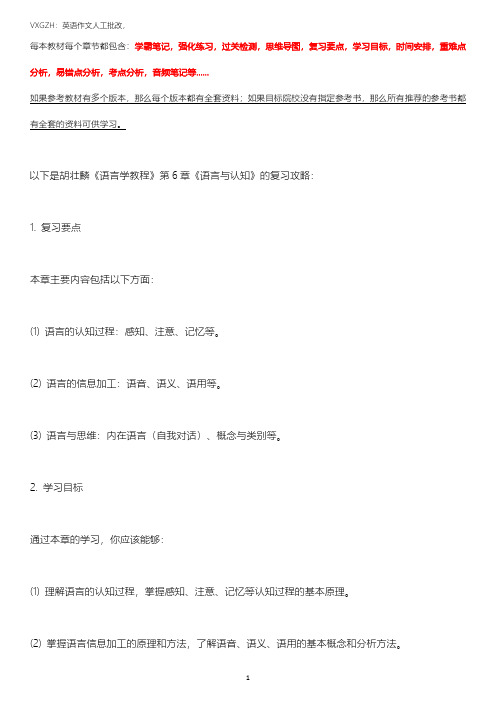
每本教材每个章节都包含:学霸笔记,强化练习,过关检测,思维导图,复习要点,学习目标,时间安排,重难点分析,易错点分析,考点分析,音频笔记等......如果参考教材有多个版本,那么每个版本都有全套资料;如果目标院校没有指定参考书,那么所有推荐的参考书都有全套的资料可供学习。
以下是胡壮麟《语言学教程》第6章《语言与认知》的复习攻略:1.复习要点本章主要内容包括以下方面:(1)语言的认知过程:感知、注意、记忆等。
(2)语言的信息加工:语音、语义、语用等。
(3)语言与思维:内在语言(自我对话)、概念与类别等。
2.学习目标通过本章的学习,你应该能够:(1)理解语言的认知过程,掌握感知、注意、记忆等认知过程的基本原理。
(2)掌握语言信息加工的原理和方法,了解语音、语义、语用的基本概念和分析方法。
(3)了解语言与思维的关系,掌握内在语言(自我对话)的特点和作用,以及概念与类别的基本概念和分类方法。
3.时间安排上午:阅读第6章,理解语言的认知过程和信息加工的原理和方法。
下午:学习语音、语义、语用的基本概念和分析方法,以及内在语言(自我对话)的特点和作用。
晚上:了解概念与类别的基本概念和分类方法,进行练习和实验操作,加深对概念和方法的理解和记忆。
4.总结通过以上复习要点和学习目标,你可以在1天内全面了解胡壮麟《语言学教程》第6章《语言与认知》的内容,并掌握语言的认知过程和信息加工的原理和方法。
同时,还应该了解语言与思维的关系,掌握内在语言(自我对话)的特点和作用,以及概念与类别的基本概念和分类方法。
建议在学习过程中注重实践和思考,多进行练习和实验操作,加深对概念和方法的理解和记忆。
同时,还应该注意扩大知识面,关注语言学的前沿研究和应用领域,为未来的学术研究和职业发展打下坚实的基础。
胡壮麟《语言学教程》(第5版)-章节题库-第6章 语言与认知【圣才出品】
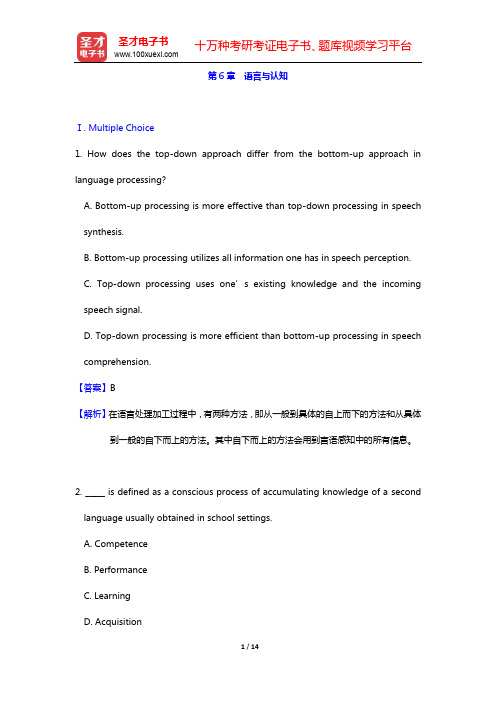
第6章语言与认知Ⅰ. Multiple Choice1. How does the top-down approach differ from the bottom-up approach in language processing?A. Bottom-up processing is more effective than top-down processing in speech synthesis.B. Bottom-up processing utilizes all information one has in speech perception.C. Top-down processing uses one’s existing knowledge and the incoming speech signal.D. Top-down processing is more efficient than bottom-up processing in speech comprehension.【答案】B【解析】在语言处理加工过程中,有两种方法,即从一般到具体的自上而下的方法和从具体到一般的自下而上的方法。
其中自下而上的方法会用到言语感知中的所有信息。
2. _____ is defined as a conscious process of accumulating knowledge of a second language usually obtained in school settings.A. CompetenceB. PerformanceC. LearningD. Acquisition【答案】C【解析】在学校里我们会学到第二语言,对第二语言知识的这种有意识的积累,叫做“学习”。
3. During language acquisition, children go through several stages, during which stage they begin to have sensitivity to the phonetic distinctions used in their parents’ language.A. Holophrastic stageB. Two word stageC. Three word stageD. Fluent grammatical conversation stage【答案】A【解析】孩子们的语言习得要经历三个阶段,单词句阶段,双词句阶段,以及三词句阶段。
(完整word版)语言学第六章之后

Chapter 6 Language and Cognition1。
语言与认知6。
1.What is Cognition认知?a。
Mental processes,information processing b。
Mental process or faculty of knowing,including awareness,perception,reasoning, and judgment.2。
The formal approach:形式法structural patterns,including the study of morphological,syntactic, and lexical structure.The psychological approach心理法: language from the view of general systems ranging from perception,memory,attention,and reasoning.The conceptual approach:认知法:how language structures (processes &patterns)conceptual content。
6。
2.Psycholinguistics心理语言学The study of the relationships between linguistic behavior and mental activity.6.2.1 Language acquirement 语言习得① Holophrastic stage独词句阶段Two word stage双词句阶段 Stage of three—word utterances三词句阶段④ Fluent grammatical conversation stage6.2.2 Language comprehension理解Mental lexicon(心智词库):information about the properties of words,retrievable when understanding language For example, we may use morphological rules to decompose a complex word like rewritable the first few times we encounter it and after several exposures we may store and access it as a unit or word。
语言学第六单元
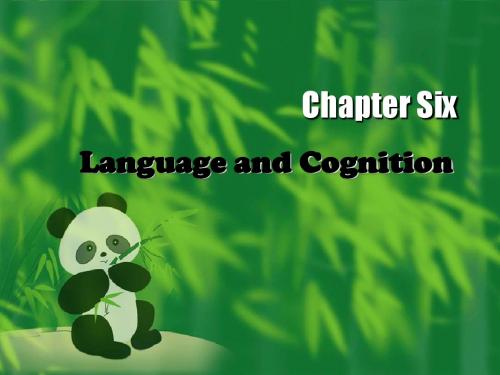
What is Cognition?
The mental process or faculty of knowing, including aspects such as awareness, perception, reasoning, and judgment.
Approaches to the Study of Language and Cognition
Judgment / Comparison
It has sth. to do with judging sth. by comparing it to sth. else. Figure-ground(图形 背景) 背景) (图形-背景 alignment(排列) applies to space (排列) with the ground as the prepositional object and the preposition expressing the spatial relational configuration 布局) (布局).
Basic Level
1. It refers to those that are most
culturally salient and are required to fulfill our cognitive needs the best. 2. This is the level where we perceive the most differences between “objects” in the world. 3. It is also the most economical ones in that it is at this level that you can find the most relevant information. (p.145)
胡壮麟语言学教程汉语

《语言学教程》汉语解释第一章 语言的性质语言的性质语言的性质 语言的定义:语言的基本特征(任意性、二重性、多产性、移位、文化传递和互换性);语言的功能(寒暄、指令、提供信息、询问、表达主观感情、唤起对方的感情和言语行为);语言的起源(神授说,人造说,进化说)等。
语言的起源(神授说,人造说,进化说)等。
第二章 语言学语言学语言学定义;研究语言的四大原则(穷尽、一致、简洁、客观);语言学的基本概念(口语与书面语、共时与历时、语言与言学、语言能力与言行运用、语言潜势与语言行为);普通语言学的分支(语音、音位、语法、句法、语义);;语言学的应用(语言学与语言教学、语言与社会、语言与文字、语言与心理学、人类语言学、神经语言学、数理语言学、计算语言学)等。
学)等。
第三章 语音学语音学发音器官的英文名称;发音器官的英文名称;英语辅音的发音部位和发音方法;英语辅音的发音部位和发音方法;英语辅音的发音部位和发音方法;语音学的定义;语音学的定义;发音语音学;发音语音学;听觉听觉语音学;声学语音学;元音及辅音的分类;严式与宽式标音等。
语音学;声学语音学;元音及辅音的分类;严式与宽式标音等。
第四章 音位学音位学音位理论;音位理论;最小对立体;最小对立体;最小对立体;自由变异;自由变异;自由变异;互补分布;互补分布;互补分布;语音的相似性;语音的相似性;语音的相似性;区别性特征;区别性特征;区别性特征;超语段音位学;超语段音位学;音节;重音(词重音、句子重音、音高和语调)等。
音节;重音(词重音、句子重音、音高和语调)等。
第五章 词法学词法学词法的定义;曲折词与派生词;构词法(合成与派生);词素的定义;词素变体;自由词素;粘着词素(词根,词缀和词干)等。
粘着词素(词根,词缀和词干)等。
第六章 词汇学词汇学词的定义;语法词与词汇词;变词与不变词;封闭词与开放词;词的辨认;习语与搭配。
词的定义;语法词与词汇词;变词与不变词;封闭词与开放词;词的辨认;习语与搭配。
《语言学教程》第 6 章 语言与认知
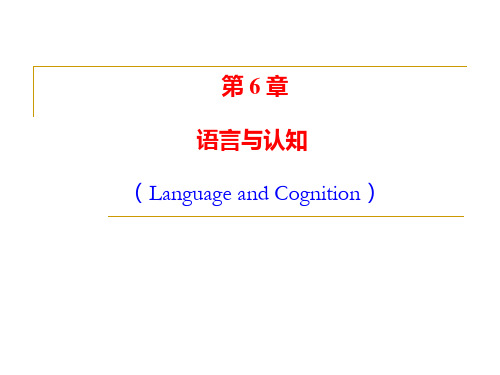
1 中国人重伦理 英美人重认知 2 中国人重整体,偏重综合性思维 英美人重个体,偏重分析性思维
3 中国人重直觉 英美人重实证
①中国传统思想注重实践经验,注重整体思考, 借助直觉体悟,通过知觉从整体上模糊而直接地 把握对象的内在本质和规律。②直觉思维强调感 性认识、灵感和顿悟;这种思维方式在词语中也 有反映。 ①英美人的思维传统是:重视理性知识,重视分 析,重视实证,通过对实证的分析得出科学、客 观的结论。
伽利略 近代实验科学的先驱者 当时的人评论:“哥伦 布发现了新大陆,而伽 利略发现了新宇宙”。 史蒂芬· 霍金说,“自然 科学的诞生要归功于伽 利略,他这方面的功劳 无人能及。”
牛顿 他对万有引力和三大 运动定律的描述奠定 了此后三个世纪里物 理学的基础,并成为 现代工程学的基础。
心理语言学的发展史
心理语言学的发展史总体上分为先乔姆斯基 时期和后乔姆斯基时期。在前一个时期,心理语 言学受心理学中的行为主义和语言学中的结构主 义的影响,着重研究语言的形式,尚未对语言使 用的心理过程作深入研究。 在乔姆斯基以后,心理语言学的研究重点发 生了变化。为验证乔姆斯基提出的一系列假设的 心理真实性,心理语言学家们设计出各种各样的 理论模型,进行各种实验,以揭开人类心理机制 这个“黑匣子”。
托马斯.爱迪生
世界历史上第一个利 用大量生产原则和工 业实验室来生产发明 专利的人。拥有2000 项发明,包括对世界 影响极大的留声机、 电影摄影机、钨丝灯 泡等。
爱迪生被誉为“光明 之父”、“现实世界 的普罗米修斯”。
托马斯.汤姆逊
他发现了电子,获诺 贝尔物理学奖。
他创立了代表现代科学的相对论,为核能开发奠定了 理论基础,开创了现代科学的新纪元,被公认为是自 伽利略、牛顿以来最伟大的科学家、物理学家。
胡壮麟《语言学教程》(第5版)笔记和考研真题详解
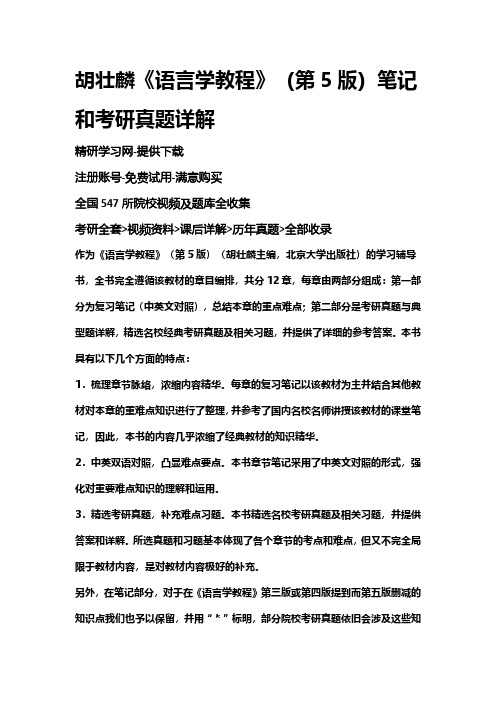
胡壮麟《语言学教程》(第5版)笔记和考研真题详解精研学习网-提供下载注册账号-免费试用-满意购买全国547所院校视频及题库全收集考研全套>视频资料>课后详解>历年真题>全部收录作为《语言学教程》(第5版)(胡壮麟主编,北京大学出版社)的学习辅导书,全书完全遵循该教材的章目编排,共分12章,每章由两部分组成:第一部分为复习笔记(中英文对照),总结本章的重点难点;第二部分是考研真题与典型题详解,精选名校经典考研真题及相关习题,并提供了详细的参考答案。
本书具有以下几个方面的特点:1.梳理章节脉络,浓缩内容精华。
每章的复习笔记以该教材为主并结合其他教材对本章的重难点知识进行了整理,并参考了国内名校名师讲授该教材的课堂笔记,因此,本书的内容几乎浓缩了经典教材的知识精华。
2.中英双语对照,凸显难点要点。
本书章节笔记采用了中英文对照的形式,强化对重要难点知识的理解和运用。
3.精选考研真题,补充难点习题。
本书精选名校考研真题及相关习题,并提供答案和详解。
所选真题和习题基本体现了各个章节的考点和难点,但又不完全局限于教材内容,是对教材内容极好的补充。
另外,在笔记部分,对于在《语言学教程》第三版或第四版提到而第五版删减的知识点我们也予以保留,并用“*”标明,部分院校考研真题依旧会涉及这些知识点的考查。
相对于第三版或第四版,对于在第五版新增加的知识点用“▼”标明,以便于使用不同版本教材的读者使用。
第1章语言学导论1.1复习笔记1.2考研真题与典型题详解第2章语音2.1复习笔记2.2考研真题与典型题详解第3章词和形态学3.1复习笔记3.2考研真题与典型题详解第4章句法:从语词到篇章4.1复习笔记4.2考研真题与典型题详解第5章意义5.1复习笔记5.2考研真题与典型题详解第6章语言与认知6.1复习笔记6.2考研真题与典型题详解第7章语言文化社会7.1复习笔记7.2考研真题与典型题详解第8章语言的使用8.1复习笔记8.2考研真题与典型题详解第9章语言与文学9.1复习笔记9.2考研真题与典型题详解第10章语言和计算机10.1复习笔记10.2考研真题与典型题详解第11章第二语言和外语教学11.1复习笔记11.2考研真题与典型题详解第12章现代语言学理论与流派12.1复习笔记12.2考研真题与典型题详解。
- 1、下载文档前请自行甄别文档内容的完整性,平台不提供额外的编辑、内容补充、找答案等附加服务。
- 2、"仅部分预览"的文档,不可在线预览部分如存在完整性等问题,可反馈申请退款(可完整预览的文档不适用该条件!)。
- 3、如文档侵犯您的权益,请联系客服反馈,我们会尽快为您处理(人工客服工作时间:9:00-18:30)。
普朗克
量子力学的创始人, 二十世纪最重要的物 理学家之一。
量子力学的发展被认 为是20世纪最重要的 科学发展,其重要性 可以同爱因斯坦的相 对论相媲美。
托马斯.爱迪生
世界历史上第一个利 用大量生产原则和工 业实验室来生产发明 专利的人。拥有2000
项发明,包括对世界 影响极大的留声机、 电影摄影机、钨丝灯 泡等。
约翰·冯·诺依曼
开创了现代计算机理 论,其体系结构沿用 至今。
微软是个人电脑软 件开发的先导,是 全球最大的软件供 应商。
微软已经渗透到了 软件界的方方面面, 所向披靡。
启示:知识就是财 富,就是影响力。
先后领导和推出了麦金 塔计算机、iMac、iPod、 iPhone等风靡全球的电子 产品,深刻改变了现代 通讯、娱乐乃至生活方 式。
1 中国人重伦理 英美人重认知
2 中国人重整体,偏重综合性思维 英美人重个体,偏重分析性思维
3 中国人重直觉 英美人重实证
①中国传统思想注重实践经验,注重整体思考, 借助直觉体悟,通过知觉从整体上模糊而直接地 把握对象的内在本质和规律。②直觉思维强调感 性认识、灵感和顿悟;这种思维方式在词语中也 有反映。
牛顿
他对万有引力和三大 运动定律的描述奠定 了此后三个世纪里物 理学的基础,并成为 现代工程学的基础。
以自然选择为核心的进化论第一次对整个生物界的发生、 发展作出了唯物的、规律性的解释,推翻了特创论等唯心 主义形而上学在生物学中的统治地位,使生物学发生了一 个革命性的变革。除了生物学外,他的理论对人类学、心 理学及哲学的发展都有不容忽视的影响。
科技等方面的变革,从而促进对自然和人类自身
ቤተ መጻሕፍቲ ባይዱ
的改造。
这些年,改变了 我们认知
方式的那些人和事
托马斯. 库恩(Thomas Samuel Kuhn)
“穷则变,变则通,通则久”
——《周易》
释义:当事物发展到极点的时候,便应该想到 要加以变化,以求通达。多指人在困境时会设 法改变现状,以求发展。
哥白尼
成部分。
3. Jean Piaget [让.皮亚杰]的认知发展理论
1. 感知运动阶段(从出生到2岁左右)。 儿童通过移动和感觉来了解事物。
爱迪生被誉为“光明 之父”、“现实世界 的普罗米修斯”。
托马斯.汤姆逊
他发现了电子,获诺 贝尔物理学奖。
他创立了代表现代科学的相对论,为核能开发奠定了 理论基础,开创了现代科学的新纪元,被公认为是自 伽利略、牛顿以来最伟大的科学家、物理学家。
史蒂芬.霍金
被誉为继爱因斯坦之 后世界上最著名的科 学思想家和最杰出的 理论物理学家。他证 明了黑洞的面积定理, 即随着时间的增加黑 洞的面积不减。
1. 原始人的直观感觉方式 2. 古代的朴素的经验知识方式 3. 近代科学和哲学作为一种认识方式和知识形态 4. 新型认知方式和知识形态
“认知革命”是人类历史发展到一定程度后
的必然,具有巨大的历史作用,是人类各种变革
的总根源,能够从根本上促进人类认识水平的提
高,带动人类在意识形态、政治、经济、文化、
①英美人的思维传统是:重视理性知识,重视分 析,重视实证,通过对实证的分析得出科学、客 观的结论。
4 中国人重形象思维 英美人重逻辑思维
小结
学习西方语言学理论,从本质上讲,就是了解 西方人的思维方式。
What is Cognitive Revolution?
①Cognitive Revolution is the name for an intellectual movement in the 1950s that began with what are known collectively as the cognitive sciences. ②It began in the modern context of greater interdisciplinary communication and research. ③The relevant areas of interchange were the combination of psychology, anthropology, and linguistics with approaches developed within the then-nascent fields of artificial intelligence, computer science, and neuroscience.
[给天才的火苗上添加利益的燃料]
认知革命的五个基本观点
1. 思维进程是以客观世界中的信息、估计和反馈 为基础的。
2. 大脑不是一块等待着打上印记的“白板”。 3. 大脑里有限的资源可以组合成无数种行为模式 4. 在不同文化中存在普遍的心理机制。 5. 大脑是一个复杂系统,包含许多相互影响的组
他提出的“日心说”沉 重打击了天主教会的
“地心说”。
他的《天球运行论》是 现代天文学的起点,也 是现代科学的起点。
从哥白尼起,自然科学 和哲学脱离了教会束缚, 开始获得飞跃式的发展。
伽利略
近代实验科学的先驱者
当时的人评论:“哥伦 布发现了新大陆,而伽 利略发现了新宇宙”。
史蒂芬·霍金说,“自 然科学的诞生要归功于 伽利略,他这方面的功 劳无人能及。”
他凭敏锐的触觉和过人 的智慧,勇于变革,不 断创新,引领全球资讯 科技和电子产品的潮流, 把电脑和电子产品变得 简约化、平民化,让曾 经昂贵稀罕的电子产品 变为现代人生活的一部 分。
林肯说美国的专利制度是 To add the fuel of interest to the fire of genius
第6 章 语言与认知 (Language and Cognition)
6.0
Introduction 导论
索绪尔和他的《普通语言学教程》
1. Noam Chomsky的Syntactic Structures(1957)的重大
意义: Cognitive Revolution(认知革命)。
知识准备:中英思维方式对比
